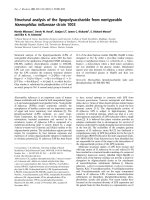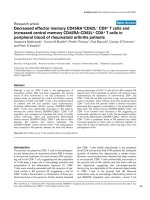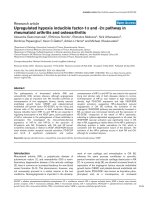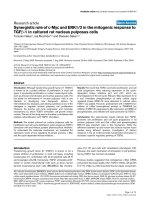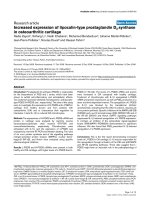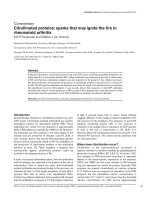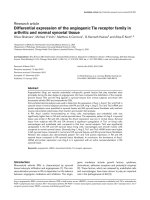Báo cáo y học: "Skewed distribution of proinflammatory CD4+CD28null T cells in rheumatoid arthritis" docx
Bạn đang xem bản rút gọn của tài liệu. Xem và tải ngay bản đầy đủ của tài liệu tại đây (859.1 KB, 11 trang )
Available online />
Research article
Vol 9 No 5
Open Access
Skewed distribution of proinflammatory CD4+CD28null T cells in
rheumatoid arthritis
Andreas ER Fasth1, Omri Snir1, Anna AT Johansson1, Birgitta Nordmark1, Afsar Rahbar2, Erik af
Klint1, Niklas K Björkström3, Ann-Kristin Ulfgren1, Ronald F van Vollenhoven1,
Vivianne Malmström1* and Christina Trollmo1*
1Rheumatology
Unit, Department of Medicine, Karolinska Institutet, Karolinska University Hospital, Stockholm, Sweden
of Medicine, Center for Molecular Medicine, Karolinska Institutet, Karolinska University Hospital, Stockholm, Sweden
3Center for Infectious Medicine, Department of Medicine, Karolinska Institutet, Karolinska University Hospital Huddinge, Stockholm, Sweden
* Contributed equally
2Department
Corresponding author: Vivianne Malmström,
Received: 24 Jun 2007 Revisions requested: 31 Jul 2007 Revisions received: 23 Aug 2007 Accepted: 7 Sep 2007 Published: 7 Sep 2007
Arthritis Research & Therapy 2007, 9:R87 (doi:10.1186/ar2286)
This article is online at: />© 2007 Fasth et al., licensee BioMed Central Ltd.
This is an open access article distributed under the terms of the Creative Commons Attribution License ( />which permits unrestricted use, distribution, and reproduction in any medium, provided the original work is properly cited.
Abstract
Expanded populations of CD4+ T cells lacking the costimulatory molecule CD28 (CD4+CD28null T cells) have been
reported in several inflammatory disorders. In rheumatoid
arthritis, increased frequencies of CD4+CD28null T cells in
peripheral blood have previously been associated with extraarticular manifestations and human cytomegalovirus (HCMV)
infection, but their presence in and contribution to joint
manifestations is not clear. In the present article we investigated
the distribution of CD4+CD28null T cells in the synovial
membrane, synovial fluid and peripheral blood of RA patients,
and analysed the association with erosive disease and anticitrullinated protein antibodies. CD4+CD28null T cells were
infrequent in the synovial membrane and synovial fluid, despite
significant frequencies in the circulation. Strikingly, the dominant
TCR-Vβ subsets of CD4+CD28null T cells in peripheral blood
were often absent in synovial fluid. CD4+CD28null T cells in
blood and synovial fluid showed specificity for HCMV antigens,
and their presence was clearly associated with HCMV
seropositivity but not with anti-citrullinated protein antibodies in
the serum or synovial fluid, nor with erosive disease. Together
these data imply a primary role for CD4+CD28null T cells in
manifestations elsewhere than in the joints of patients with
HCMV-seropositive rheumatoid arthritis.
Introduction
NK cell-related receptors and lack the co-stimulatory molecule
CD28; the cells are therefore often referred to as
CD4+CD28null T cells [5,6].
T cells are likely to play an important role in the pathogenesis
of rheumatoid arthritis (RA) (reviewed in [1]). In the synovial
joint, infiltrating T cells are predominantly of the CD4+ phenotype and are often found in the proximity of B cells and macrophages. These T cells could either represent cells potentiating
the function of infiltrating leukocytes or represent suppressive
regulatory T cells. Neither specific autoantigens nor autoreactive T cells have so far been conclusively demonstrated in RA.
However, a distinct population of oligoclonally expanded
proinflammatory CD4+ T cells is found with increased frequencies in peripheral blood in RA patients compared with healthy
control individuals [2-4]. These cells display a proinflammatory
phenotype, are terminally differentiated, express a variety of
The presence of these CD4+CD28null T cells in peripheral
blood has been associated with human cytomegalovirus
(HCMV) seropositivity, extra-articular manifestations and cardiovascular disease in RA patients [7-9]. Despite increased
frequencies of CD4+CD28null T cells in the circulation of RA
patients, however, their contribution to erosive disease is still
unclear: while studies from Pawlik and colleagues and
Goronzy and colleagues found associations between circulating CD4+CD28null T cells and erosive disease [4,10], Martens
ACPA = anti-citrullinated protein antibodies; ELISA = enzyme-linked immunosorbent assay; HCMV = human cytomegalovirus; IFN = interferon; IL =
interleukin; RA = rheumatoid arthritis; TCR = T-cell receptor; TNF = tumour necrosis factor.
Page 1 of 11
(page number not for citation purposes)
Arthritis Research & Therapy
Vol 9 No 5
Fasth et al.
and colleagues and Gerli and colleagues did not observe such
associations [3,9].
We had a unique opportunity to investigate the presence of
these CD4+CD28null T cells in the synovial membrane, the synovial fluid and peripheral blood from the same patients in a
large cohort of RA patients. The association with erosive disease and the levels of antibodies to citrullinated peptides/antigens was examined. Furthermore, CD4+CD28null T cells
isolated from the synovial fluid were investigated with regard
to antigen specificity and selective recruitment to the joint.
Materials and methods
Patients
One hundred and twenty-eight patients with RA were enrolled
in the study. All fulfilled the American College of Rheumatology
criteria for RA and attended the Rheumatology Clinic at Karolinska University Hospital, Stockholm, Sweden for corticosteroid injections of inflamed joints [11]. Before the corticosteroid
injections, synovial fluids were acquired from the knee joints (n
= 128), the elbow (n = 1) or the shoulder joints (n = 2). Eighty
per cent of the patients were women, median age of 56 years
(range, 25–82 years) and a median disease duration of 9
years (range, 0–45 years).
Assessment of erosive disease was performed by radiographic evaluations of the ankle joints or wrist joints by the
same two rheumatologists. Radiographic changes in one or
more joints were found in 51 out of 70 (73%) patients
included in these analyses. The majority of the patients were
treated either with nonsteroidal anti-inflammatory drugs, with
systemic or local corticosteroid treatment, with methotrexate
alone or in combination with corticosteroids (prednisolone), or
with TNF blockers alone or in combination with methotrexate.
Some patients were untreated.
This study was approved in compliance with the Helsinki Declaration by the Ethics Committee of the Karolinska University
Hospital, and all patients and healthy subjects gave informed
consent.
Arthroscopy and synovial biopsies
Knee joint synovial biopsies were acquired according to a previously described procedure [12]. Biopsies were taken at the
site of inflammation, either close to cartilage or not close to
cartilage, defined as either less than 1.5 cm or more than 1.5
cm from cartilage, respectively.
Three-colour immunofluorescence microscopy
Frozen unfixed synovial biopsy sections were fixed with acetone. Sections were incubated overnight with the cocktail of
primary antibodies – CD244 (R&D Systems, Minneapolis, MN,
USA), CD4 (Becton Dickinson, San Jose, CA, USA), CD3
(DakoCytomation, Glostrup, Denmark) – or the isotype control
antibodies – goat IgG (Caltag Laboratories, Burlingame, CA,
Page 2 of 11
(page number not for citation purposes)
USA), mouse IgG1 (DakoCytomation) and rabbit immunoglobulin (DakoCytomation). Excess of antibodies were washed
away before incubation with the secondary antibodies – antisheep/goat immunoglobulin-biotin (The Bidning Site, Birmingham, UK), avidin-Oregon Green 488 (Molecular Probes,
Eugene, OR, USA), anti-mouse IgG-Rhodamine RedTM-X
(Jackson ImmunoResearch Laboratories, West Grove, PA,
USA) and anti-rabbit IgG-AMCA (Jackson ImmunoResearch).
Stained tissue sections were examined with a Leica DM RXA2
microscope (Leica Microsystems, Wetzlar, Germany)
equipped with a Leica DC 300F (Leica Microsystems DI,
Cambridge, UK) digital colour video camera connected to a
PC computer. Photographs were analysed with Leica IM500
software (Leica Microsystems, Heerbrugg, Switzerland).
CD4+CD28null T cells were identified by morphologically celllike structures with co-localized immunostainings of CD3,
CD4 and CD244, and were manually quantified in independent analyses performed by two persons. CD4dim macrophages/monocytes and NK cells [13], which also might
express CD244, could be excluded using the combination of
CD3 and CD4 in the three-colour stainings to identify CD4+ T
cells. The density of CD4+CD28null T cells were calculated by
dividing the number of CD4+CD28null T cells by the total area
of infiltrating T cells, measured with Image J software version
1.34s (National Institutes of Health, Bethesda, MD, USA).
Flow cytometry
The frequency of CD4+CD28null T cells in peripheral blood and
synovial fluid was analysed by four-colour flow cytometry
(FACSCalibur instrument; Becton Dickinson Immunocytometry Systems, San Jose, CA, USA) in peripheral blood mononuclear cells and synovial fluid mononuclear cells after Ficoll
separation (Ficoll-Paque Plus; GE Healthcare Biosciences
AB, Uppsala, Sweden). The antibodies used were CD3-FITC,
CD28-APC (Pharmingen; Becton Dickinson, San Diego, CA,
USA), CD4-PerCP (Becton Dickinson, San Jose) and CD244PE (Immunotech, Marseille, France).
The TCR-Vβ usage was determined by the IOTest1 Beta Mark
kit (Beckman Coulter, Marseille, France). The TCR-Vβ stainings were combined with antibodies to CD4 and CD28 (see
above) to identify CD4+CD28null T cells and CD4+CD28+ T
cells.
Peripheral blood mononuclear cells and synovial fluid mononuclear cells stimulated with HCMV antigens (see below) were
analysed by flow cytometry after immunostaining with IFNγFITC, CD28-PE, CD3-APC and CD14-APC-Cy7 (all from
Becton Dickinson, San Diego, CA, USA) and CD4-PerCp
(Becton Dickinson, San Jose, CA, USA).
Flow cytometric data were analysed with CellQuest software
(Becton Dickinson, Franklin Lakes, NJ, USA) or FlowJo
Available online />
software (Tree Star Inc., Ashland, OR, USA). The frequency of
CD4+CD28null T cells was calculated as the percentage of
CD28-negative cells in the gated CD3+CD4+ population.
the CD28null subset in peripheral blood of patients with RA
and muscle tissue of patients with myositis (Figure 1) (Fasth et
al., submitted).
Functional assays
The functional capacity of CD4+CD28null T cells from the synovial fluid and peripheral blood were assessed by IFN-γ production. Two million peripheral blood mononuclear cells and
synovial fluid mononuclear cells from eight patients were either
stimulated with plate-bound anti-CD3 antibodies (OKT-3) at 0
or 0.1 μg/ml for 4 hours, or by 2 μg/ml pp65 and immediate
early HCMV antigens (JPT Peptide Technologies GmbH, Berlin, Germany) for 8 hours.
CD244 is hitherto mainly described as a receptor regulating
activation of NK cells after interaction with its ligand CD48
[15]. CD244 might have similar functions on T cells, but this is
not yet fully understood [16]. Instead of detecting T cells lacking CD28, CD4+CD28null T cells in synovial membrane biopsies were identified by co-expression of CD244, CD3 and
CD4 (Figure 1). Two patient groups were analysed: patients
having less than 0.5% and patients having more than 7% of
circulating CD4+CD28null T cells (Table 1). In all 11 patients,
as expected, CD3-positive cells were abundant in the synovial
membrane, and a majority of the CD3-positive cells also
expressed CD4 (Figure 1). Only small numbers of
CD4+CD28nullCD244+ T cells were found. They were evenly
distributed and without correlation with the size of the T-cell
infiltrates, the frequencies of CD4+CD28null T cells in peripheral blood or with ongoing medication. From these results we
conclude that the vast majority of CD4+CD28null T cells do not
home specifically to the synovial membrane despite significant
frequencies in the circulation.
Activated cells were either detected by secretion (MACS
Secretion Assay; Miltenyi Biotec, Bergisch Gladbach, Germany) or by upregulation of intracellularly stored IFN-γ (Becton
Dickinson, San Diego, CA, USA) according to the manufacturers' protocols. The frequency of IFN-γ secreting
CD3+CD4+CD28null T cells was analysed by flow cytometry
(see above).
Enzyme-linked immunosorbent assay
The anti-CCP2 test (Immunoscan RA, Mark 2; Euro-Diagnostica, Arnhem, The Netherlands) was used to determine the levels of anti-citrullinated peptide/protein antibodies (ACPA) in
the serum and synovial fluid. A cutoff value of 25 U/ml was
used according to the manufacturer's instructions. Serum and
synovial fluid samples were diluted equally (1:50) and were
analysed on the same plate.
The presence of anti-HCMV IgG and IgM antibodies in the
serum and the synovial fluid, from the same time point as the
screening of CD4+CD28null T cells, was tested in an enzygnost anti-HCMV/IgG ELISA and an enzygnost anti-HCMV/IgM
ELISA (Dade Behring, Marburg, Germany). Sera from HCMVseronegative patients were further examined for detection of
IgG against HCMV using antigens prepared from a HCMV
clinical isolate (C6) using an ELISA as previously described by
Rahbar and colleagues [14]. Control antigen was prepared
from uninfected fibroblasts.
Statistical analyses
Comparisons of nonparametrically distributed data in two
independent groups or compartments were performed by the
Mann–Whitney test. The Spearman test for correlation was
used for analyses of covariation of two nonparametrically distributed data.
Results
CD4+CD28null T cells are scarce in the synovial membrane
To investigate the presence of CD4+CD28null T cells in the
synovial membrane, we used three-colour immunofluorescence microscopy. This technique utilizes our findings of
CD244 expression by CD4+ T cells as a specific marker for
CD4+CD28null T cells are restricted to HCMV-seropositive
patients and are less frequent in synovial fluid than in
peripheral blood
We then analysed the presence of CD4+CD28null T cells in the
synovial fluid by screening synovial fluid samples from 128
patients by flow cytometry. CD4+CD28null T cells could be
detected in synovial fluid at a median frequency of 1.9%
(range 0–27%). These percentages, however, were significantly lower than in paired peripheral blood samples (median,
4.4%; range, 0–50%; P < 0.001) (Figure 2a). Despite significant differences in the two compartments, patients with the
largest population of CD4+CD28null T cells in the synovial fluid
still tended to have the highest frequencies in peripheral blood
(r = 0.47, P < 0.0001) (Figure 2b).
Analysis of 14 patients with two simultaneous synovial fluid
samples demonstrated that the presence of CD4+CD28null T
cells in one inflamed joint reflects the occurrence also in other
affected joints (Figure 2c). Patient groups undergoing different medical treatments (untreated, nonsteroidal anti-inflammatory drug, methotrexate or TNF blockade) did not have
different frequencies of CD4+CD28null T cells in the peripheral
blood or the synovial fluid (data not shown).
Increased frequencies of circulating CD4+CD28null T cells in
patients with RA have been associated with HCMV infection;
whether this is also valid for synovial CD4+CD28null T cells is
not known. Strikingly, we found significant CD4+CD28null Tcell populations only in the synovial fluid of HCMV-seropositive
individuals (P < 0.01) (Figure 2d). Comparative analysis of the
frequencies of CD4+CD28null T cells in the synovial fluid and
Page 3 of 11
(page number not for citation purposes)
Arthritis Research & Therapy
Vol 9 No 5
Fasth et al.
Figure 1
CD4+CD28null T cells are rare in the synovial membrane Representative immunostaining of one patient, using three-colour immunofluorescence
membrane.
microscopy, to identify CD4+CD28null T cells in the inflamed synovial membrane. The four photographs depict each marker alone or superimposed of
the same area of Patient 3 (Table 1): CD3 (blue), CD4 (red) and CD244 (green). Arrows indicate CD4+CD28null (CD3+CD4+CD244+) T cells. Original magnification, ×32. Inserted flow cytometry panel displays the expression CD244 and CD28 on CD3+CD4+ T cells in peripheral blood.
peripheral blood of HCMV IgG-seropositive patients clearly
showed that CD4+CD28null T cells were less frequent in synovial fluid compared with peripheral blood also in this subset of
patients (P < 0.0001) (Figure 2f). The serum titres of antiHCMV IgG correlated with the levels in the synovial fluid (r =
0.87, P < 0.0001; data not shown). Seven patients (15%) displayed both anti-HCMV IgM and anti-HCMV IgG antibodies,
indicating a recent or ongoing infection, but the frequency of
CD4+CD28null T cells in the circulation and synovial fluid was
similar to IgG-seropositive patients lacking IgM (data not
shown).
These data demonstrate that CD4+CD28null T cells are only
present in the synovial fluid and peripheral blood of RA
patients seropositive for HCMV, and demonstrate that,
despite significant frequencies in peripheral blood,
CD4+CD28null T cells are infrequent in the synovial
compartment.
CD4+CD28null T cells from synovial fluid are functional
and reactive to HCMV antigens
We have previously reported that CD4+CD28null T cells from
the peripheral blood rapidly respond to low TCR stimulation
mimicked by a low concentration of anti-CD3 antibodies [6].
To investigate whether CD4+CD28null T cells in the synovial
fluid displayed the same hyperresponsiveness, we measured
the frequency of IFN-γ-secreting CD4+CD28null T cells in
mononuclear cells from synovial fluid. Indeed, these cells
Page 4 of 11
(page number not for citation purposes)
showed a similar response as CD4+CD28null T cells from the
peripheral blood (Figure 3, upper panel), indicating that
CD4+CD28null T cells in the synovial compartment have a
capacity to function as local effector T cells.
With the strong association between CD4+CD28null T cells
and HCMV seropositivity we also investigated whether IFN-γ
production could be provoked from CD4+CD28null T cells in
peripheral blood and synovial fluid, after stimulation by the
HCMV-derived pp65 and immediate early antigens. Interestingly, synovial fluid-derived CD4+CD28null T cells from all
investigated patients showed specificity for these antigens
(Figure 3, lower panel). These results indicate that HCMVderived peptides can activate at least a subset of
CD4+CD28null T cells to function as effector T cells.
Selected subsets of CD4+CD28null T cells have access to
the inflamed joint
Hitherto we have shown that CD4+CD28null T cells are less
frequent in the synovial fluid compared with peripheral blood.
We next investigated whether there was a selective recruitment of certain subsets of CD4+CD28null T cells to the joint.
Using antibodies detecting 24 different TCR-Vβ chains, we
could identify TCR-Vβ subsets of the CD4+CD28null T-cell
population in both peripheral blood and synovial fluid. Two distinct patterns of TCR-Vβ distribution were found in the joint.
Available online />
Table 1
Summary of patients investigated for CD4+CD28null T cells in synovial membrane biopsies
Patient
Gender,
age (years)
Disease
duration
(years)
Treatmenta
Erosive
disease
CD3+ in
synovial
membraneb
CD4+CD28null T cells
Peripheral
blood (%)
Synovial
fluid (%)
n/T-cell
infiltratec
n/mm2 T-cell
infiltratec
>5% CD4+CD28null T cells in peripheral blood
1
Female, 69
1
P, M
-
++
18
6
3
35
2
Female, 45
15
N, L
+
+
9.8
10.4
2.5
54
3
Female, 67
2.75
N
+
++
7.6
6.5
5
47
4
Female, 51
33
N, P
+
+++
13
1.5
4.7
48
5
Male, 74
26
N, P, E
+
++
8.6
2.7
0.8
5
6
Male, 38
22
N, M, E
+
++
8
0.8
2
39
<1%
CD4+CD28null T
cells in peripheral blood
7
Male, 45
13
N
+
+
0
0.4
1.3
53
8
Male, 25
0.6
N, P, M
-
++
0
0.2
3
51
9
Female, 60
Several
years
N, D
-
++
0
0.1
0
0
10
Male, 41
1
P
+
+++
0.4
0.8
4.5
67
11
Female, 66
10
M
+
++
0.4
0.6
0
0
aP,
prednisolone; M, methotrexate; N, nonsteroidal anti-inflammatory drug; L, leflunomid; E, etanercept; D, depomedrol. bRelative size of infiltrating
CD3+ cells in the synovial membrane specimen: +, <25% T cells in the tissue area; ++, approximately 50% T cells in the tissue area; +++, >75%
T cells in the tissue area. cAverage numbers of CD4+CD28null T cells in one to five analysed infiltrates.
In six of the 13 patients analysed, the dominant TCR-Vβ within
the CD4+CD28null T-cell population in peripheral blood was
also present in the joint. In one such representative patient,
with total frequencies of 7%, 1% and 1.5% CD4+CD28null T
cells in the circulation, in the left knee synovial fluid and in the
right knee synovial fluid respectively, 29–36% of the
CD4+CD28null T cells in all three compartments expressed
TCR-Vβ13.1 (Figure 4a). In contrast, synovial fluid from five
patients displayed a clear exclusion of the dominant
CD4+CD28null T cells from peripheral blood. In the most prominent case, a patient with total frequencies of 9%
CD4+CD28null T cells in peripheral blood and 4% in the synovial fluid, 71.5% of the CD4+CD28null T cells in the circulation
expressed Vβ20 but only 4.5% of the cells in the joint
expressed Vβ20. In contrast, there was an enrichment of TCRVβ5.1-expressing CD4+CD28null T cells in the joint (Figure
4b). Patients with the restricted pattern did not display lower
overall frequencies of synovial fluid CD4+CD28null T cells as
compared with patients with the same TCR-Vβ dominance in
peripheral blood and synovial fluid. Neither did different medical treatments co-segregate with either pattern of TCR-Vβ distribution (data not shown). Interestingly, in one patient
displaying two TCR-Vβ subsets covering more than 75% of
the circulating CD4+CD28null population, one of the subsets
had access to, and was even significantly enriched in, the synovial fluid, while the other dominant subset was clearly
restricted (Figure 4c). Two patients did not display any of
these distinct patterns of TCR-Vβ distribution.
In all 13 patients, the distribution of TCR-Vβ subsets in the
conventional CD4+CD28+ T-cell population was not dramatically different in the synovial fluid from that in peripheral blood,
as illustrated in Figure 4a–c. These results suggest that the
access of CD4+CD28null T cells to the joint is restricted to certain TCR-Vβ subsets, and that RA patients can be divided into
two distinct groups with regard to different access of
CD4+CD28null T-cell subsets to the joint.
Associations between CD4+CD28null T cells, ACPA and
erosive disease
The presence of ACPA is RA specific and is an early predictor
of an aggressive disease course [17,18]. We therefore analysed whether the frequencies of CD4+CD28null T cells in the
circulation and in the synovial fluid were associated with the
presence of ACPA in these compartments. We found no
differences in the frequencies of circulating or synovial
CD4+CD28null T cells in patients with or without ACPA in
these locations (Figure 5a,b).
To investigate the association between CD4+CD28null T cells
and erosive disease, we allocated patients into two clearly distinguishable groups of either significant erosive disease (n =
Page 5 of 11
(page number not for citation purposes)
Arthritis Research & Therapy
Vol 9 No 5
Fasth et al.
Figure 2
blood.
Skewed distribution of CD4+CD28null T cells in synovial fluid and peripheral blood (a) Paired samples of synovial fluid (SF) and peripheral blood
(PB) from 128 rheumatoid arthritis patients were compared for the frequency of CD4+CD28null T cells by flow cytometry. (b) Frequencies of
CD4+CD28null T cells in SF tend to be higher in patients with large populations in PB. (c) Comparison of the frequency of CD4+CD28null T cells in
SF from two different synovial compartments. Open circle, elbow; open squares, shoulder joints. Frequencies of CD4+CD28null T cells in (d) SF and
(e) PB in patients seronegative and seropositive for human cytomegalovirus (HCMV). (f) Frequencies of CD4+CD28null T cells in paired PB and SF
of patients seropositive for HCMV.
21) or no signs of erosive disease (n = 16) according to radiographic evaluations. We had access to longitudinal follow-up
data on patients without erosions up to 10 years after disease
onset; therefore, patients allocated to the erosive group also
had a disease duration of a maximum 10 years. Since subgroups of patients with different treatment did not display different frequencies of CD4+CD28null T cells either in peripheral
blood or in synovial fluid, treatment was not considered a
parameter to stratify for in this analysis. The results indicated
that CD4+CD28null T cells were not specifically enriched in the
joint or peripheral blood of patients with erosive disease (Figure 5c,d), which is in accordance with the lack of correlation
with ACPA levels.
Page 6 of 11
(page number not for citation purposes)
Increased frequencies of CD4+CD28null T cells have been
associated with extra-articular manifestations [3,4]. Three
cases of such manifestations were reported in our cohort. One
patient, rheumatoid factor-positive and HLA-B27-positive,
with iritis had no CD4+CD28null T cells either in blood or the
synovial fluid. In contrast, two patients with pleurisy had 31%
and 33% CD4+CD28null T cells in peripheral blood and 2.3%
and 6.4% in the synovial fluid, respectively. Despite only two
patients, these observations are in line with the notion of an
association between CD4+CD28null T cells and extra-articular
manifestations in RA.
Available online />
Figure 3
CD4+CD28null T cells from peripheral blood and synovial fluid show human cytomegalovirus specificity (upper panel) The functional capacity of
specificity.
CD4+CD28null T cells in peripheral blood (PB) and synovial fluid (SF) was investigated after stimulation of mononuclear cells from paired PB and SF
from rheumatoid arthritis patients by plate-bound anti-CD3 antibodies. (lower panel) The reactivity of CD4+CD28null T cells in paired PB and SF to
human cytomegalovirus (HCMV) antigens was analysed after stimulation by the pp65 or immediate early (IE) antigens.
Taken together, our data from peripheral blood and the
inflamed synovial joint show no association between the presence of CD4+CD28null T cells and joint destruction.
Discussion
Herein we demonstrate that only minor populations of
CD4+CD28null T cells were present in the inflamed joints of RA
patients, despite significant percentages in peripheral blood.
The presence of CD4+CD28null T cells in peripheral blood and
the synovial fluid was strongly associated with HCMV IgG
seropositivity, but not with ACPA or erosive disease.
Our results on the presence of CD4+CD28null T cells in the synovial fluid were based on screening for CD3+CD4+CD28- cells.
It was therefore important to consider the stability of the CD28negative phenotype. Data from in vitro experiments indicate that
cytokines such as TNF and IL-12 in synovial fluid can modify
CD28 expression, complicating the analyses of CD4+CD28null
T cells in the joint [19,20]. We believe our data, however, not to
be biased by the cytokines present in the synovial fluid since
there was no over-representation of synovial CD4+CD28+ T
cells expressing the TCR-Vβ chains preferentially expressed by
peripheral blood CD4+CD28null T cells (Figure 4). Interestingly,
previous studies have shown a reduction in the frequency of
CD4+CD28null T cells in peripheral blood after TNF blockade
[9,21-23]. In our cohort, neither TNF blockade nor any of the
other most frequently used medical treatments (untreated, nonsteroidal anti-inflammatory drug, methotrexate) was associated
with the distribution of CD4+CD28null T cells in the synovial fluid,
peripheral blood and synovial tissue. It is therefore likely that the
effect of TNF blockade on CD4+CD28null T cells is primarily
seen when comparing the same patients before and after treatment, rather than comparing heterogeneous groups of patients
with and without this treatment.
CD4+CD28null T cells from both peripheral blood and synovial
fluid demonstrated reactivity to HCMV-derived antigens. That
the frequency of responding CD4+CD28null T cells was higher
in the synovial fluid compared with the peripheral blood does
not necessarily mirror an accumulation of HCMV-reactive
CD4+CD28null T cells in this compartment, since the same
effect was seen for CD4+CD28+ T cells (data not shown).
These differences might instead be due to a different status of
accessory cells from the two compartments. We also analysed
the HCMV specificity of the dominant TCR-Vβ subsets of
CD4+CD28null T cells from two patients comprising 20% and
29% of the total CD4+CD28null population in both peripheral
blood and synovial fluid. Interestingly, the TCR-Vβ dominant
CD4+CD28null T-cell subsets did not respond either to pp65
or to immediate early antigens, indicating that the TCR-Vβ
dominant subsets might be reactive to antigens other than
those considered immunodominant for HCMV (data not
shown). This might be explained by a hypothesis suggested by
Davenport and colleagues, who demonstrate that during
chronic Esptein–Barr virus infections T-cell clones reactive to
the most dominant epitopes rapidly decrease after primary
infection and that clonotypes reactive to less dominant
epitopes control the recurrent infections [24]. At present,
Page 7 of 11
(page number not for citation purposes)
Arthritis Research & Therapy
Vol 9 No 5
Fasth et al.
Figure 4
Restricted access of CD4+CD28null T-cells subset to synovial fluid. (a) TCR-Vβ repertoire of CD4+CD28null T cells (left) and CD4+CD28+ T cells
fluid
(right) from peripheral blood (PB, filled bars) and synovial fluid (SF, open bars) from one patient with similar frequencies of TCR-Vβ in the
CD4+CD28null populations in PB and SF. (b) TCR-Vβ repertoire of CD4+CD28null T cells (left) and CD4+CD28+ T cells (right) from PB and SF from
one patient with different frequencies in TCR-Vβ in the CD4+CD28null population in PB and SF. (c) TCR-Vβ repertoire of CD4+CD28null T cells (left)
and CD4+CD28+ T cells (right) from PB and SF in one patient: one of the two dominant CD4+CD28null T-cell TCR-Vβ subsets in PB was present in
SF with even higher frequencies than in PB, while the access of the other dominant subset in PB was significantly restricted. In this patient, the T
cells were only screened for selected TCR-Vβ chains.
however, we can not exclude that some of the CD4+CD28null
T cells with access to the joint have specificity for cartilagederived and/or citrllinated candidate antigens.
It is intriguing that only certain subsets of CD4+CD28null T
cells reach the synovial fluid. Since we were not able to detect
all possible TCR-Vβ chains, we cannot exclude that there is an
even more pronounced discrimination of CD4+CD28null T cells
expressing nondetectable TCR-Vβ chains. The reason for this
skewed distribution of CD4+CD28null T cells in peripheral
blood and synovial fluid, both with regard to subsets of
Page 8 of 11
(page number not for citation purposes)
CD4+CD28null T cells and to the size of whole populations,
can with present knowledge only be speculated upon. Owing
to the strong association of CD4+CD28null T cells to HCMV
seropositivity, it is tempting to assume that the location or status of the HCMV infection plays an important role. Because of
the increased frequencies in peripheral blood and exclusion
from the synovial fluid, it is probable that tissues other than the
rheumatic joint are the primary homing sites for CD4+CD28null
T cells in these patients. The few CD4+CD28null T cells found
in the joint could instead be a consequence of general patrolling initiated by infection in other tissues. A widespread distri-
Available online />
Figure 5
CD4+CD28null T cells do not associate with erosive disease. Frequency of CD4+CD28null T cells in paired samples of synovial fluid (left column) and
erosive disease
peripheral blood (right column) from (a), (b) patients seronegative (ACPA-) and seropositive (ACPA+) for anti-citrullinated peptide/protein antibodies, and (c), (d) patients with or without erosive disease.
bution of virus-specific T cells in a site other than the actual
site of virus infection has previously been demonstrated in
mouse models [25]. Further investigations considering the
expression of chemokine receptors/integrins, antigen specificity, location of the HCMV infection and the presentation of
HCMV antigens are needed to clarify this issue. The frequency
of CD4+CD28null T cells in the synovial fluid does not necessarily reflect the situation in the inflamed synovia, although in
our cohort the low CD4+CD28null T-cell frequencies in the synovial fluid were in agreement with the modest numbers in the
inflamed synovial membrane.
CD4+CD28null T cells isolated from the synovial fluid could
function as effector T cells by rapid secretion of IFN-γ. Interestingly, IFN-γ is only scarcely found in the T-cell infiltrates of the
rheumatic synovial membrane and has therefore not been considered a key cytokine in the pathogenesis of RA [26]. Several
reports instead indicate the importance of IL-17, and recent
publications have further shown that IFN-γ counteracts the differentiation of IL-17-producing T cells [27-29]. Since
CD4+CD28null T cells produce IFN-γ but not IL-17 [6,30], it is
possible that CD4+CD28null T cells, if activated in the joint by
secretion of IFN-γ, might even inhibit the synovial inflammation
in RA.
The limited presence of CD4+CD28null T cells in the synovial
fluid, despite increased frequencies in peripheral blood and
their equal distribution in patients with and patients without
erosive disease, indicates no significant role for CD4+CD28null
T cells in the local inflammation driving joint destruction.
Instead, these data indirectly support the previously suggested role for these cells in extra-articular manifestations and
cardiovascular disease. That is, CD4+CD28null T cells are
exclusively present in HCMV IgG-seropositive RA patients and
are reactive to HCMV antigens (present study and [7]),
CD4+CD28null T cells only have limited access to the inflamed
joint despite increased frequencies in the circulation (present
study), increased frequencies of CD4+CD28null T cells do not
correlate with erosive disease (present study and [3,9]), RA
patients with high frequencies of circulating CD4+CD28null T
cells display increased risk for cardiovascular events
compared with patients lacking CD4+CD28null T cells [9,31],
CD4+CD28null T cells have been found in atherosclerotic
plaques and can mediate lysis of endothelial cells in vitro
[32,33], HCMV is frequently found in atherosclerotic and nonatherosclerotic vascular walls [34], and HCMV increases the
thrombogenicity of endothelial cells [35].
CD4+CD28null T cells and HCMV might not be the only mediators of cardiovascular events in RA, but these studies
together strongly link CD4+CD28null T cells and HCMV infecPage 9 of 11
(page number not for citation purposes)
Arthritis Research & Therapy
Vol 9 No 5
Fasth et al.
tion to cardiovascular events, which is found with increased
prevalence and is the major cause of death in patients with RA.
2.
3.
Conclusion
In the present study we have shown that CD4+CD28null T cells
in RA only are present in HCMV-seropositive patients and display a skewed distribution in the inflamed joint compared with
that in peripheral blood. Consistent with the limited number of
CD4+CD28null T cells in the joints, these cells were not associated with joint destruction indicated by radiographic analyses or ACPA antibodies predictive of erosive disease.
4.
5.
6.
Competing interests
The authors declare that they have no competing interests.
7.
Authors' contributions
AERF was responsible for the study design, performed laboratory work (preparation of blood and synovial fluid samples,
flow cytometry analyses, development, analyses of the immunofluorescence microscopy, and HCMV reactivity assays), statistical analyses, interpretation of the data, and drafted the
manuscript. OS performed and interpreted data from in vitro
stimulation assays as well as ACPA ELISAs of serum and synovial fluid. AATJ performed and analysed the immunofluorescence stainings. BN contributed to the clinical evaluation of
the patient cohort together with EaK, who also performed the
arthroscopies. AR carried out and evaluated the results from
the HCMV ELISAs. NKB set up the flow cytometric assays for
investigation of the CD244 expression. A-KU was responsible
for the biobank of arthroscopic biopsies and participated in
the development of immunofluorescence stainings. RvV contributed to the clinical evaluations of patients and manuscript
preparation. VM and CT were the principle investigators and
participated equally in the planning and coordination of the
study, interpretation of data, and drafting the manuscript. All
authors read and approved the final manuscript.
8.
9.
10.
11.
12.
13.
14.
Acknowledgements
The authors would like to thank Dr Cecilia Söderberg-Naucler for helpful
discussion in HCMV-related issues, Dr Florian Kern and Charlotte Tammik for providing the protocol and reagents for the HCMV reactivity
assay, Eva Jemseby for organizing sampling, storage and administration
of biomaterial, and Marianne Engström for technical support with the
immunofluorescence microscopy stainings. This study was supported
by Alex and Eva Wallstrom, Borje Dahlin, Tore Nilsson, Magn. Bergvall,
Nanna Svartz, and Åke Wiberg Foundations, the Swedish Association
againt Rheumatism, the Swedish Medical Association, the King Gustaf
the V:s 80 year Foundation, the Swedish Research Council and the EU
FP6 project, AutoCure LSHB CT-2006-018661, 2. This publication
reflects only the author's views; the European Community is not liable for
any use that may be made of the information herein.
15.
16.
17.
18.
References
1.
Lundy SK, Sarkar S, Tesmer LA, Fox DA: Cells of the synovium
in rheumatoid arthritis. T lymphocytes. Arthritis Res Ther 2007,
9:202-212.
19.
20.
Page 10 of 11
(page number not for citation purposes)
Schmidt D, Martens PB, Weyand CM, Goronzy JJ: The repertoire
of CD4+ CD28- T cells in rheumatoid arthritis. Mol Med 1996,
2:608-618.
Martens PB, Goronzy JJ, Schaid D, Weyand CM: Expansion of
unusual CD4+ T cells in severe rheumatoid arthritis. Arthritis
Rheum 1997, 40:1106-1114.
Pawlik A, Ostanek L, Brzosko I, Brzosko M, Masiuk M, Machalinski
B, Gawronska-Szklarz B: The expansion of CD4+CD28- T cells in
patients with rheumatoid arthritis. Arthritis Res Ther 2003,
5:R210-R213.
Warrington KJ, Takemura S, Goronzy JJ, Weyand CM:
CD4+,CD28- T cells in rheumatoid arthritis patients combine
features of the innate and adaptive immune systems. Arthritis
Rheum 2001, 44:13-20.
Fasth AE, Cao D, van Vollenhoven R, Trollmo C, Malmström V:
CD28nullCD4+ T cells – characterization of an effector memory
T-cell population in patients with rheumatoid arthritis. Scand
J Immunol 2004, 60:199-208.
Hooper M, Kallas EG, Coffin D, Campbell D, Evans TG, Looney RJ:
Cytomegalovirus seropositivity is associated with the expansion of CD4+CD28- and CD8+CD28- T cells in rheumatoid
arthritis. J Rheumatol 1999, 26:1452-1457.
Fletcher JM, Vukmanovic-Stejic M, Dunne PJ, Birch KE, Cook JE,
Jackson SE, Salmon M, Rustin MH, Akbar AN: Cytomegalovirusspecific CD4+ T cells in healthy carriers are continuously
driven to replicative exhaustion.
J Immunol 2005,
175:8218-8225.
Gerli R, Schillaci G, Giordano A, Bocci EB, Bistoni O, Vaudo G,
Marchesi S, Pirro M, Ragni F, Shoenfeld Y, Mannarino E:
CD4+CD28- T lymphocytes contribute to early atherosclerotic
damage in rheumatoid arthritis patients. Circulation 2004,
109:2744-2748.
Goronzy JJ, Matteson EL, Fulbright JW, Warrington KJ, ChangMiller A, Hunder GG, Mason TG, Nelson AM, Valente RM, Crowson CS, et al.: Prognostic markers of radiographic progression
in early rheumatoid arthritis. Arthritis Rheum 2004, 50:43-54.
Arnett FC, Edworthy SM, Bloch DA, McShane DJ, Fries JF, Cooper
NS, Healey LA, Kaplan SR, Liang MH, Luthra HS, et al.: The American Rheumatism Association 1987 revised criteria for the
classification of rheumatoid arthritis. Arthritis Rheum 1988,
31:315-324.
Baeten D, Van den Bosch F, Elewaut D, Stuer A, Veys EM, De Keyser F: Needle arthroscopy of the knee with synovial biopsy
sampling: technical experience in 150 patients.
Clin
Rheumatol 1999, 18:434-441.
Bernstein HB, Plasterer MC, Schiff SE, Kitchen CM, Kitchen S,
Zack JA: CD4 expression on activated NK cells: ligation of CD4
induces cytokine expression and cell migration. J Immunol
2006, 177:3669-3676.
Rahbar AR, Sundqvist VA, Wirgart BZ, Grillner L, Söderberg-Naucler C: Recognition of cytomegalovirus clinical isolate antigens
by sera from cytomegalovirus-negative blood donors. Transfusion 2004, 44:1059-1066.
Bryceson YT, March ME, Ljunggren HG, Long EO: Synergy
among receptors on resting NK cells for the activation of natural cytotoxicity and cytokine secretion.
Blood 2006,
107:159-166.
Assarsson E, Kambayashi T, Persson CM, Chambers BJ, Ljunggren HG: 2B4/CD48-mediated regulation of lymphocyte activation and function. J Immunol 2005, 175:2045-2049.
Rönnelid J, Wick MC, Lampa J, Lindblad S, Nordmark B, Klareskog
L, van Vollenhoven RF: Longitudinal analysis of citrullinated protein/peptide antibodies (anti-CP) during 5 year follow up in
early rheumatoid arthritis: anti-CP status predicts worse disease activity and greater radiological progression. Ann Rheum
Dis 2005, 64:1744-1749.
Machold KP, Stamm TA, Nell VP, Pflugbeil S, Aletaha D, Steiner G,
Uffmann M, Smolen JS: Very recent onset rheumatoid arthritis:
clinical and serological patient characteristics associated with
radiographic progression over the first years of disease.
Rheumatology (Oxford) 2007, 46:342-349.
Bryl E, Vallejo AN, Weyand CM, Goronzy JJ: Down-regulation of
CD28 expression by TNF-alpha.
J Immunol 2001,
167:3231-3238.
Warrington KJ, Vallejo AN, Weyand CM, Goronzy JJ: CD28 loss in
senescent CD4+ T cells: reversal by interleukin-12 stimulation.
Blood 2003, 101:3543-3549.
Available online />
21. Pawlik A, Ostanek L, Brzosko I, Brzosko M, Masiuk M, Machalinski
B, Szklarz BG: Therapy with infliximab decreases the
CD4+CD28- T cell compartment in peripheral blood in patients
with rheumatoid arthritis. Rheumatol Int 2004, 24:351-354.
22. Bryl E, Vallejo AN, Matteson EL, Witkowski JM, Weyand CM,
Goronzy JJ: Modulation of CD28 expression with anti-tumor
necrosis factor alpha therapy in rheumatoid arthritis. Arthritis
Rheum 2005, 52:2996-3003.
23. Rizzello V, Liuzzo G, Brugaletta S, Rebuzzi A, Biasucci LM, Crea F:
Modulation of CD4(+)CD28null T lymphocytes by tumor necrosis factor-alpha blockade in patients with unstable angina.
Circulation 2006, 113:2272-2277.
24. Davenport MP, Fazou C, McMichael AJ, Callan MF: Clonal selection, clonal senescence, and clonal succession: the evolution
of the T cell response to infection with a persistent virus. J
Immunol 2002, 168:3309-3317.
25. Masopust D, Vezys V, Usherwood EJ, Cauley LS, Olson S, Marzo
AL, Ward RL, Woodland DL, Lefranỗois L: Activated primary and
memory CD8 T cells migrate to nonlymphoid tissues regardless of site of activation or tissue of origin. J Immunol 2004,
172:4875-4882.
26. Smeets TJ, Dolhain R, Miltenburg AM, de Kuiper R, Breedveld FC,
Tak PP: Poor expression of T cell-derived cytokines and activation and proliferation markers in early rheumatoid synovial
tissue. Clin Immunol Immunopathol 1998, 88:84-90.
27. Chabaud M, Durand JM, Buchs N, Fossiez F, Page G, Frappart L,
Miossec P: Human interleukin-17: a T cell-derived proinflammatory cytokine produced by the rheumatoid synovium.
Arthritis Rheum 1999, 42:963-970.
28. Park H, Li Z, Yang XO, Chang SH, Nurieva R, Wang YH, Wang Y,
Hood L, Zhu Z, Tian Q, Dong C: A distinct lineage of CD4 T cells
regulates tissue inflammation by producing interleukin 17.
Nat Immunol 2005, 6:1133-1141.
29. Harrington LE, Hatton RD, Mangan PR, Turner H, Murphy TL, Murphy KM, Weaver CT: Interleukin 17-producing CD4+ effector T
cells develop via a lineage distinct from the T helper type 1 and
2 lineages. Nat Immunol 2005, 6:1123-1132.
30. van Bergen J, Thompson A, van der Slik A, Ottenhoff TH, Gussekloo J, Koning F: Phenotypic and functional characterization of
CD4 T cells expressing killer Ig-like receptors. J Immunol
2004, 173:6719-6726.
31. Warrington KJ, Kent PD, Frye RL, Lymp JF, Kopecky SL, Goronzy
JJ, Weyand CM: Rheumatoid arthritis is an independent risk
factor for multi-vessel coronary artery disease: a case control
study. Arthritis Res Ther 2005, 7:R984-R991.
32. Liuzzo G, Goronzy JJ, Yang H, Kopecky SL, Holmes DR, Frye RL,
Weyand CM: Monoclonal T-cell proliferation and plaque instability in acute coronary syndromes.
Circulation 2000,
101:2883-2888.
33. Nakajima T, Schulte S, Warrington KJ, Kopecky SL, Frye RL,
Goronzy JJ, Weyand CM: T-cell-mediated lysis of endothelial
cells in acute coronary syndromes.
Circulation 2002,
105:570-575.
34. Kilic A, Onguru O, Tugcu H, Kilic S, Guney C, Bilge Y: Detection
of cytomegalovirus and Helicobacter pylori DNA in arterial
walls with grade III atherosclerosis by PCR. Pol J Microbiol
2006, 55:333-337.
35. Rahbar A, Söderberg-Naucler C: Human cytomegalovirus infection of endothelial cells triggers platelet adhesion and
aggregation. J Virol 2005, 79:2211-2220.
Page 11 of 11
(page number not for citation purposes)


